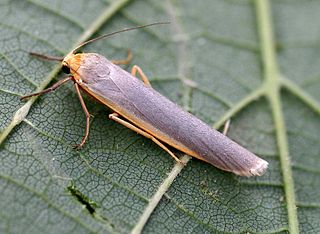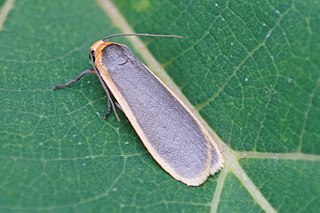
Manulea complana, the scarce footman, is a moth of the family Erebidae. The species was first described by Carl Linnaeus in his 1758 10th edition of Systema Naturae. It is found throughout the Palearctic region.

Manulea is a genus of moths in the family Erebidae erected by Hans Daniel Johan Wallengren in 1863. The type species is Lithosia gilveola Ochsenheimer, 1810.
Manulea pseudocomplana is a moth of the family Erebidae. It is found from central and southern Europe to Ukraine, Turkey and Iran.

Manulea (Setema) cereola is a moth of the family Erebidae. It is found in Fennoscandia, the Baltic States, European Russia as well as the Alps and Urals. The species was first described by Jacob Hübner in 1803.
Collita coreana is a moth of the family Erebidae. It is found in Korea. Records for the Russian Far East and Japan are probably based on misidentifications of Manulea ussurica.
Manulea costalis is a moth of the family Erebidae. It is found in Albania, Bulgaria, Serbia, North Macedonia, Greece and on Crete, as well as in Turkey and Armenia. on the Andamans and from India to Myanmar.
Manulea flavociliata is a moth of the family Erebidae. It is found in north-eastern Kazakhstan, southern Siberia, the Russian Far East, Mongolia, China and Korea.
Manulea pseudofumidisca is a moth of the family Erebidae. It is found in Russia, North Korea and China.
Manulea minor is a moth of the family Erebidae. It is found in the Russian Far East and Japan.
Manulea affineola is a moth of the family Erebidae. It is found in the Russian Far East (Primorye), Korea, China (Shaanxi) and Japan.

Manulea japonica is a moth of the family Erebidae. It is found on the Kuril Islands (Kunashir) and in China, Korea and Japan. It has a wingspan of 25–30 mm.
Manulea kansuensis is a moth of the family Erebidae. It is found from Russia (Transbaikalia), through Mongolia to Gansu, China.
Manulea nankingica is a moth of the family Erebidae first described by Franz Daniel in 1954. It is found in the Russian Far East (Primorye), China (Jiangsu), Korea and Japan.
Manulea omelkoi is a moth of the family Erebidae. It is found in the Russian Far East.
Manulea predotae is a moth of the family Erebidae. It is found in Portugal and Spain.
Manulea ussurica is a moth of the family Erebidae. It is found in the Russian Far East (Primorye), China and Korea.
Manulea wiltshirei is a moth of the family Erebidae. It is found in south-western Asia, including Lebanon.
Manulea atratula is a moth of the family Erebidae. It is found in Russia, Mongolia and North Korea.

Manulea bicolor, the bicolored moth or yellow-edged footman, is a moth of the family Erebidae. It is found in boreal North America, from Labrador and Massachusetts to Yukon and British Columbia. In the Rocky Mountains, it ranges south to southern Colorado. The habitat consists of boreal forests, parklands and riparian cottonwoods in the prairies.
Manulea hunanica is a moth of the family Erebidae. It is found in China.




